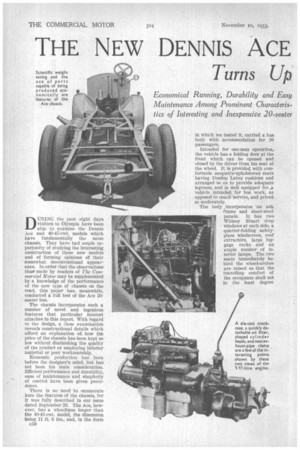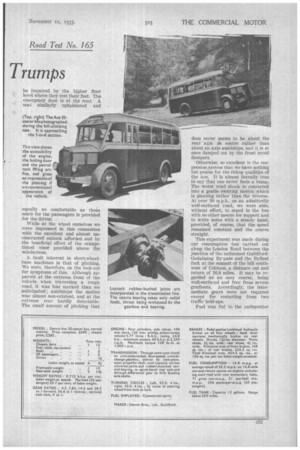THE NEW DENNIS ACE
Page 80

Page 81

Page 82

If you've noticed an error in this article please click here to report it so we can fix it.
Turns Up
Trumps
Economical Running, Durability and Easy Maintenance Among Prominent Characterise. tics of Interesting and Inexpensive 20-seater
DTIRING the past eight days visitors to Olympia have been able to examine the Dennis Ace and 40-45-cwt. models which have fundamentally the same chassis. They have had ample opportunity of studying the interesting construction of these new models and of forming opinions of their somewhat unconventional appearance. In order that the observations thug made by readers of The Commercial Motor may be supplemented by a knowledge of the performance of the new type of chassis on the road, this paper has, meanwhile, conducted a full test of the Ace 20seater bus.
The chassis incorporates such a number of novel and ingenious features that particular interest attaches to this report. With regard to the design, a close examination reveals constructional details which afford an explanation of how the price of the chassis has been kept so low without diminishing the quality of the product or employing inferior material or poor workmanship.
Economic production has been before the designer's mind, but has not been his main consideration. Efficient performance and durability, ease of maintenance and simplicity of control have been given precedence.
There is no need to enumerate ,here the features of the chassis, for it was fully described in our issue dated September 29. The Ace, however, has a wheelbase longer than the 40-45-cwt. model, the dimension being 11 ft. 6 ins., and, in the form c50 in which we tested it carried a bus body with accommodation for 20 passengers.
Intended for one-man operation, the vehicle has a folding door at the front which can be opened and closed by the driver from his seat at the wheel. It is provided with comfortable moquette-upholstered seats having Dunlop Latex cushions and arranged so as to provide adequate legroom, and is well equipped for,a vehicle intended for bus work, as opposed to coach service, and priced so moderately.
The body _incorporates 'an ash frame and sheet-steel panels. It has two Widney Stuart drop windows at each side, a quarter-folding safetyglass windscreen, roof extractors, large luggage racks and an ample number of interior lamps. The two seats immediately behind the wheel-arches are raised so that the travelling comfort of the occupants shall not in the least degree he impaired by the higher floor level where they rest their feet. The emergency door is at the rear. A seat similarly upholstered and
equally as comfortable as thoie seats for the passengers is provided for the driver.
While at the wheel ourselves we. were impressed in this connection with the excellent and almost unobstructed outlook afforded and by the beneficial effect of the orangetinted visor provided above the windscreen.
A. fault inherent in short7wheelbase machines is that of pitching. We were, therefore, on the look-out for symptoms of this. Although apparent at the extreme front of the vehicle when traversing a rough road, it was less marked than we anticipated ; amidships the motion was almost non-existent, and at the extreme rear hardly detectable. The small amount of pitching that
does occur seems to be about the rear axle ais centre rather than about an axis amidships, and it is at once damped out by the front recoil clam pers.
Otherwise, so excellent is the suspension ,system that we have nothing but-praise for the riding qualities of the Ace. It is Almost literally .true to say that one never feels a bump. The worst road Shock is converted into a gentle swaying motion which is pleasing rather than the reverse. At over 30 m.p.h., on all admittedly well-surfaced road, we were able, without effort, to stand in the bus with no other means for support and to write notes with a steady hand, provided, of course, that the speed remained constant and the course straight.
This experiment was made during our consumption test carried out along the London Road between the junction of the unfinished GuildfordGodalming By-pas and the Byfleet fork at the summit of the bill southwest of Cobham, a distance out and return of 16.8 miles. It may be regarded as an easy course, being well-surfaced and free from severe gradients. Accordingly, the intermediate gears were not required except for restarting from two traffic hold-ups.
Fuel was fed to the carburetter from a test tank into which a measured gallon had been poured, and the length of the route, therefore, represents the consumption figure16.8 m.p.g. or 336 passenger-m.p.g., for the bus was, of course, laden to represent service conditions. Comparing this figure with the average results of road tests carried out by us over the year ended last May, we find that petrolengined 2i-tonners averaged 12.9 m.p.g., and that petrol-enginecl onetonners avyaged 17.8 m.p.g. Accordingly, the figure we obtained may be regarded as creditable.
The hill chosen for an observed ascent was that known as Coombe Bottom, which runs, roughly, northwards from the Guildford-Dorking road at a point just on the Guildford side of Shere. It is approximately a mile in length and incorporates at its steepest part-1 in 6a sharp left-hand bend which is approached by a lengthy stretch of 1 in 10. A non-stop ascent occupied 4 mins. 11 sees, which gives an average speed of 14.3 m.p.h. Third gear carried us from the foot to the beginning of the steeper Section; then our speed fell to 11 m.p.h., when " second " was engaged.
The slope eases somewhat a little farther on, which fact allowed the speed to rise to 18 m.p.h. As the corner was neared it dropped again, and on this portion, at about 9 m.p.h., " first " was brought into use. During the pause for the engagement of the lowest ratio, the vehicle lost momentum, and when the engine picked up the load again It conld not have been moving at more than a walking pace. Thence, however, it accelerated to the summit. Remarkable silence in all gears results from the use of pinions having double-contact teeth.
Immediately after the non-stop climb, the temperature of the cooling water was found to be 179 degrees F.—about 125 degrees above the temperature of the atmosphere.
The approach to this hill branches from the main road very obliquely, so that turning from it towards Guildford, a sharp angle has to be negotiated. It served to show up a most valuable property of the Ace, which swung out on to the main road with yards to spare.
Of comparatively low speed, the 60 b.h.p. power unit in this new Dennisdevelops 30 b.h.p. at 1,000 r.p.m.; consequently, its top-gear
performance is remarkable. , This fact is disclosed by the accompanying acceleration graph, in which the quickly rising,. speeds in top and third gears are recorded. Under ordinary conditions, one hardly ever has to use the gear lever.
A contributory factor to the flexibility of the engine is the ingenious system of automatic ignitiontiming control. The spark is advanced and retarded according to the appropriate conditions of engine speed and carburetter suction. The action of the simple centrifugal control is modified—neutralized or amplified—by a vacuum device in connection with the induction pipe, the orifice of the pipe line being so placed that it is closed when the throttle valve is in the shut position. High suction advances the timing. It will be observed from the braking graph that to use the hand lever to supplement the pedal improves the retardation a little, whilst the hand brake alone is not greatly inferior to the service brake, although the former acts only on the rear wheels. This apparently points to a high standard of efficiency in the mechanical linkage, and to a choice of leverages, and so forth, in the hydraulic system
that gives a compromise between muscular effort and braking effect unlikely to provoke wheel locking or skidding in normal circumstances. The brakes are unquestionably powerful and effective, yet devoid of -fierceness. They come into operation with a deceiving smoothness.
With little need to use the gear lever, no engine controls beyond the accelerator, a feather-light clutch, an efficient and well-placed hand brake, a foot brake requiring a wellchosen degree of exertion to operate, and excellent steering, the machine makes the minimum demands upon the driver's skill and endurance.
In the Ace, Dennis Bros., Ltd, has evolved a design that, in many ways, represents a distinct advance. In view of its many advantageous features, the reputation of its maker's name, and the workmanship and materials it embodies, it indeed seems cheap at its price, as a chassis, of i285. We do not wonder that its maker is optimistic about its future success.




























































































































